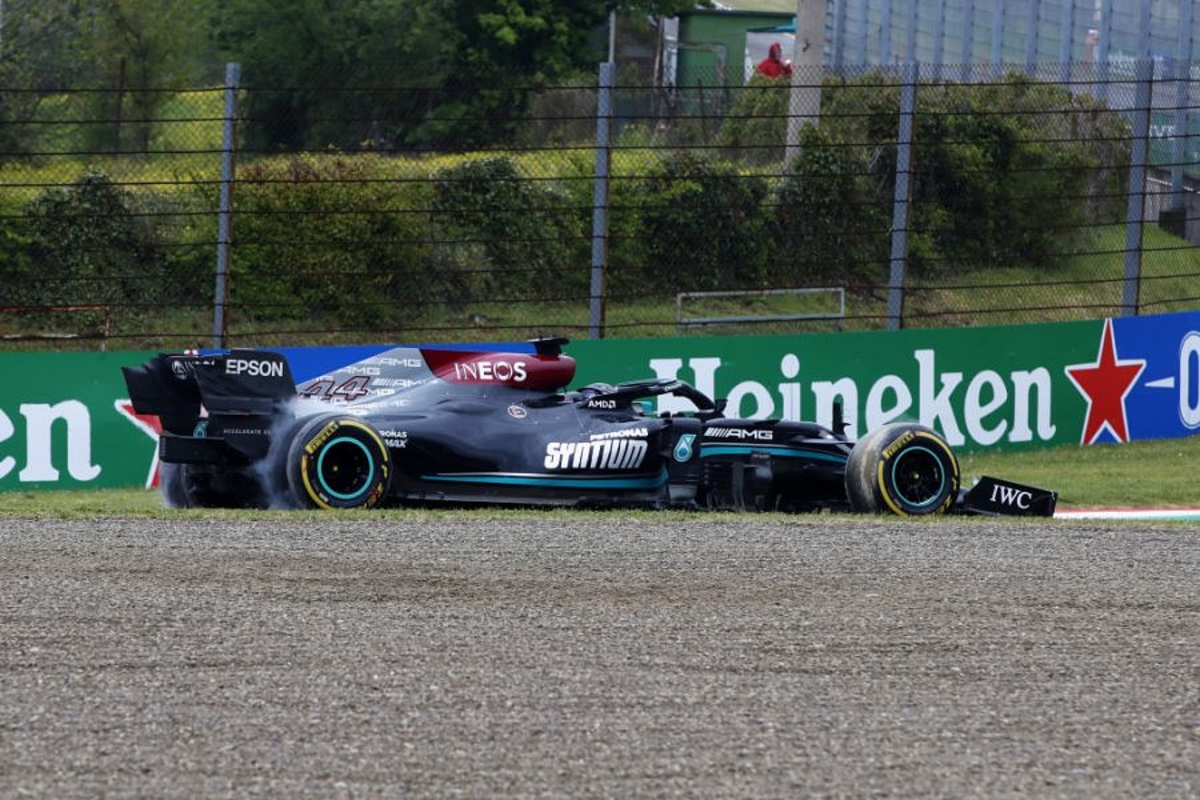
Why Hamilton avoided penalty for reversing on track
Why Hamilton avoided penalty for reversing on track

Lewis Hamilton's reversal on to the Imola racetrack following his minor crash raised eyebrows at the time given the seemingly dangerous nature of the manoeuvre.
But FIA race director Michael Masi has cleared Hamilton of any wrongdoing, with the seven-time Formula 1 champion and his Mercedes team supported by the rules.
Hamilton's Emilia Romagna Grand Prix ran into difficulties when he attempted to lap Williams driver George Russell at Tosa, only to hit a damp part of the track in doing so.
That sent Hamilton into the gravel, with the 36-year-old then making a misjudgment in trying to turn out of the trap as he crunched his front wing against a barrier.
Following a lengthy period of time, Hamilton finally found the correct gear and chose to reverse all the way back across the gravel and on to the edge of the track before heading to the pits for a new front wing and tyres.
Masi has made clear it was Mercedes' clear and precise instructions to Hamilton that ensured no penalty was applied.
"Looking at the incident at the time, it was reversing out of the gravel trap towards the edge of the circuit," said Masi.
"Listening to Lewis' radio between him and his team, they were absolutely advising him all the way through, so in that particular circumstance, I wouldn't consider reporting that to the stewards."
Asked as to what circumstances reversal of a car would be punished, Masi replied: "It's a case-by-case basis that you need to review the complete set of circumstances around it."
The FIA's sporting regulations additionally point to the fact Hamilton did nothing wrong.
While the rules make clear under article 28.3 that "at no time may a car be reversed in the pit lane under its own power", different regulations apply to the track.
Article 27.3 states that “should a car leave the track the driver may re-join, however, this may only be done when it is safe to do so and without gaining any lasting advantage."
While 27.4 adds that "at no time may a car be driven unnecessarily slowly, erratically or in a manner which could be deemed potentially dangerous to other drivers or any other person".
The fact Hamilton was guided throughout by Mercedes who would have used GPS tracking data to monitor the position of other cars before relaying messages ensured he did not flout the rules.
Hamilton recognised, though, he faced anxious moments in the gravel before going on to stage a recovery drive to finish second behind Max Verstappen.
Explaining what unfolded with selecting reverse, Hamilton said: "It just wouldn’t go into reverse so I was holding the reverse button and it took forever to engage.
"I didn’t think it was going to work. I tried reversing and then tried to kind of do a burn-out spin to get going again and I was back in the barrier so then it took a long time again to get back in reverse.
"And when I was reversing, I was like I’ve just got to keep going backwards and work my way out in reverse and if I hadn’t done that I would probably still have been there now so I’m grateful for it."
Related
Change your timezone:
Latest News

F1 News Today: Horner reveals Verstappen SECRET as team reveal surprise name change
- 1 hour ago

Ferrari announce DRASTIC change as Verstappen issues dire warning to bosses - GPFans F1 Recap
- Today 00:27

Hamilton sends strong message over Gaza deaths
- Yesterday 22:57

F1 giants announce name change with IMMEDIATE effect
- Yesterday 21:57

Horner admits Red Bull at MAJOR disadvantage with new rules
- Yesterday 20:57

Horner reveals 'unhuman' Verstappen secret
- Yesterday 19:57
Related news

Hamilton sends strong message over Gaza deaths

Former F1 chief hits out at Hamilton 'EXCUSES'

Hamilton struggles pinned on Mercedes by team's OWN driver

Cocky sporting legend CHALLENGES Hamilton in stunning claim
F1 Standings

Drivers
- Oliver Bearman
- Charles Leclerc
- Carlos Sainz
- Lando Norris
- Oscar Piastri
- Pierre Gasly
- Esteban Ocon
- Sergio Pérez
- Max Verstappen
- Alexander Albon
- Logan Sargeant
- Lewis Hamilton
- George Russell
- Nico Hülkenberg
- Kevin Magnussen
- Fernando Alonso
- Lance Stroll
- Valtteri Bottas
- Zhou Guanyu
- Daniel Ricciardo
- Yuki Tsunoda
Races
-
 Gulf Air Grand Prix of Bahrain 2024
Gulf Air Grand Prix of Bahrain 2024
-
 Saudi Arabian Grand Prix 2024
Saudi Arabian Grand Prix 2024
-
 Grand Prix of Australia 2024
Grand Prix of Australia 2024
-
 MSC Cruises Grand Prix of Japan 2024
MSC Cruises Grand Prix of Japan 2024
-
 Grand Prix of China 2024
Grand Prix of China 2024
-
 Miami Grand Prix 2024
Miami Grand Prix 2024
-
 Gran Premio dell'Emilia Romagna 2024
Gran Premio dell'Emilia Romagna 2024
-
 Grand Prix of Monaco 2024
Grand Prix of Monaco 2024
-
 Grand Prix du Canada 2024
Grand Prix du Canada 2024
-
 Gran Premio de España 2024
Gran Premio de España 2024
-
 Grand Prix of Austria 2024
Grand Prix of Austria 2024
-
 Grand Prix of Great Britain 2024
Grand Prix of Great Britain 2024
-
 Grand Prix of Hungary 2024
Grand Prix of Hungary 2024
-
 Grand Prix of Belgium 2024
Grand Prix of Belgium 2024
-
 Heineken Dutch Grand Prix 2024
Heineken Dutch Grand Prix 2024
-
 Grand Prix of Italy 2024
Grand Prix of Italy 2024
-
 Grand Prix of Azerbaijan 2024
Grand Prix of Azerbaijan 2024
-
 Grand Prix of Singapore 2024
Grand Prix of Singapore 2024
-
 Grand Prix of the United States 2024
Grand Prix of the United States 2024
-
 Gran Premio de la Ciudad de Mexico 2024
Gran Premio de la Ciudad de Mexico 2024
-
 Grande Prêmio de São Paulo 2024
Grande Prêmio de São Paulo 2024
-
 Heineken Silver Las Vegas Grand Prix 2024
Heineken Silver Las Vegas Grand Prix 2024
-
 Qatar Grand Prix 2024
Qatar Grand Prix 2024
-
 Grand Prix of Abu Dhabi 2024
Grand Prix of Abu Dhabi 2024
About GPFans
GPFans is a multi-platform, multi-language brand dedicated to Formula One coverage. We bring you all the ins and outs of the sport, 24/7, everything from up-to-the-minute news and features to the latest viral stories and clips.We believe that a new generation of exciting, outspoken drivers will make F1 more popular than ever before, and we want to give our users access to as much of their heroes as possible, on and off the track. From Lewis Hamilton to Max Verstappen, Daniel Ricciardo to Sebastian Vettel, we provide in-depth analysis of every every Grand Prix in the season, from Australia to Abu Dhabi.
With Formula One under the new ownership of Liberty Media, how the sport is being covered is evolving, and GPFans will look to be at the heart of this progression into new media, as one of the fastest-growing sites covering the king of motorsports.
Follow us on your favorite social media channel
Corporate & Media
 Innovatieweg 20C
Innovatieweg 20C7007 CD, Doetinchem, Netherlands
+31645516860



















 Gulf Air Grand Prix of Bahrain 2024
Gulf Air Grand Prix of Bahrain 2024  Saudi Arabian Grand Prix 2024
Saudi Arabian Grand Prix 2024  Grand Prix of Australia 2024
Grand Prix of Australia 2024  MSC Cruises Grand Prix of Japan 2024
MSC Cruises Grand Prix of Japan 2024  Grand Prix of China 2024
Grand Prix of China 2024  Gran Premio dell'Emilia Romagna 2024
Gran Premio dell'Emilia Romagna 2024  Grand Prix of Monaco 2024
Grand Prix of Monaco 2024  Grand Prix du Canada 2024
Grand Prix du Canada 2024  Gran Premio de España 2024
Gran Premio de España 2024  Grand Prix of Austria 2024
Grand Prix of Austria 2024  Grand Prix of Hungary 2024
Grand Prix of Hungary 2024  Grand Prix of Belgium 2024
Grand Prix of Belgium 2024  Grand Prix of Azerbaijan 2024
Grand Prix of Azerbaijan 2024  Grand Prix of Singapore 2024
Grand Prix of Singapore 2024  Gran Premio de la Ciudad de Mexico 2024
Gran Premio de la Ciudad de Mexico 2024  Grande Prêmio de São Paulo 2024
Grande Prêmio de São Paulo 2024  Qatar Grand Prix 2024
Qatar Grand Prix 2024  Grand Prix of Abu Dhabi 2024
Grand Prix of Abu Dhabi 2024